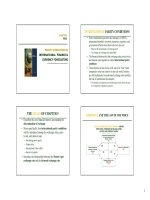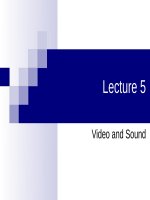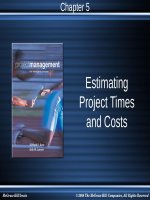Lecture supply chain management chapter 5 deliveringdistribution
Bạn đang xem bản rút gọn của tài liệu. Xem và tải ngay bản đầy đủ của tài liệu tại đây (16.83 MB, 30 trang )
1/14/20
Chapter 5:
DELIVERY/DISTRIBUTION
MsC. Bui Thi Bich Lien
LOGO
Contents
1
§Introduction
2
§Physical distribution activities
3
§Delivery Scheduling
4
§Members in distribution channel
5
§Distribution channels system
1
1/14/20
Learning objectives
§ Gain the physical distribution aspect of
supply chains
§ Apply the principles of physical distribution
into practice
§ Calculate distribution costs
1. Introduction
§ Physical supply vs. Physical distribution
§ Physical supply: is the movement and
storage of goods from suppliers to
manufacturing.
§ Physical distribution: Physical distribution,
on the other hand, is the movement and
storage of finished goods from the end of
production to the customer
2
1/14/20
3
1/14/20
Reverse logistics
4
1/14/20
5
1/14/20
CLASSIFY DELIVERY METHOD
According to the nature of delivery relations
According to locations of delivery
Delivery to customer’s location
Delivery to the “Hub” of network
2. Physical distribution activities
§ WHAT:
§ Physical distribution is responsible for delivering to
the customer what is wanted on time and at
minimum cost.
§ HOW:
§ The objective of distribution management is to
design and operate a distribution system that attains
the required level of customer service and does so
at least cost. To reach this objective, all activities
involved in the movement and storage of goods
must be organized into an integrated system.
6
1/14/20
WAREHOUSES AND DISTRIBUTION CENTRE
DISTINGUISH WAREHOUSE AND DC
Traditional
Warehouses
Focus on storage
Distribution
Centre
Focus on services and speed of
good movement through SC
7
1/14/20
Order management
§ Order management is the process of
passing
order
information
from
customers back through the supply chain
from retailers to distributors to service
providers and producers.
§ This process also includes passing
information about order delivery dates,
product substitutions, and back orders
forward through the supply chain to
customers.
§ This process has long relied on the use
of the telephone and paper documents
such as purchase orders, sales orders,
change orders, pick tickets, packing lists,
and invoices
8
1/14/20
9
1/14/20
The path of a customer’s order
Example
10
1/14/20
11
1/14/20
Total cost of Distribution
and cost
12
1/14/20
3. Delivery Scheduling
§ Direct deliveries
§ Milk - run deliveries
13
1/14/20
Direct Delivery
§ Single voyage
§ A à B: choosing the shortage route
§ Shipment: usually only 1 shipment
§ Big volume and thinly delivery frequency
§ Advantages: simple in operation and
moderation
§ Disadvantages: do not consolidate cargo in
different routes à wastes
Direct Delivery Application
§ Big volume cargo, take the advantage of
capacity’s mean of transport
§ Delivery positions is far away from each
other
§ Delivered to agents in each area of
company.
14
1/14/20
15
1/14/20
Milk – run delivery from 1 point to many points
16
1/14/20
Milk-run Delivery
Đ Methods used:
ã Saving matrix
ã Methods of general assignment
Vehicle Scheduling Problem
§ The objectives of the vehicle scheduling problem can be many.
§ Following are some examples:
§ Minimize number of vehicles required
§ Minimize total distance traveled
§ Minimize total travel time
§ Minimize cost
§ We shall consider the problem with the objective of minimizing
total distance.
34
17
1/14/20
Vehicle Scheduling Problem
X Coordinate
Y Coordinate
Order Size
W
0
0
1
0
12
48
2
6
5
60
3
7
15
43
4
9
12
92
5
15
3
80
Assume that the customer locations and order sizes
are as shown above. Capacity is 200
35
Vehicle Scheduling Problem
3
4
1
2
5
W
Location of Warehouse and Customers
The customer locations shown on the previous
slide are plotted above.
36
18
1/14/20
Savings Matrix Method
•
Following are the steps of the Savings Matrix
Method:
1. Identify distance matrix
2. Identify savings Matrix
3. Rank savings
4. Assign customers to vehicles
5. Sequence customers within routes
37
Identify Distance Matrix
Warehouse
Customer 1
Customer 2
Customer 3
Customer 4
Customer 5
Distance Matrix
W Cust 1 Cust 2 Cust 3 Cust 4 Cust 5
0 12.0
7.8 16.6 15.0
15.3
0
9.2
7.6
9.0
17.5
0 10.0
7.6
9.2
0
3.6
14.4
0
10.8
0
Dist ( A, B ) =
Example :
Dist (1,2) =
(x A
- xB ) + ( y A - y B )
2
2
38
19
1/14/20
Rank Savings
Savings Matrix
Cust 1 Cust 2 Cust 3 Cust 4 Cust 5
Customer 1
0 10.6 20.9 18.0
9.8
Customer 2
0 14.3 15.2 13.9
Customer 3
0 27.9 17.4
Customer 4
0 19.5
Customer 5
0
Rank
(3,4)
(2,4)
(1,3)
(2,3)
(4,5)
(2,5)
(1,4)
(1,2)
(3,5)
(1,5)
39
Assign Customers to Vehicles
3
Customer
4
1
5
2
1
2
3
4
5
Order
Size
48
60
43
92
80
W
Location of Warehouse and Customers
Rank
(3,4)
(2,4)
(1,3)
(2,3)
(4,5)
(2,5)
(1,4)
(1,2)
(3,5)
(1,5)
40
20









